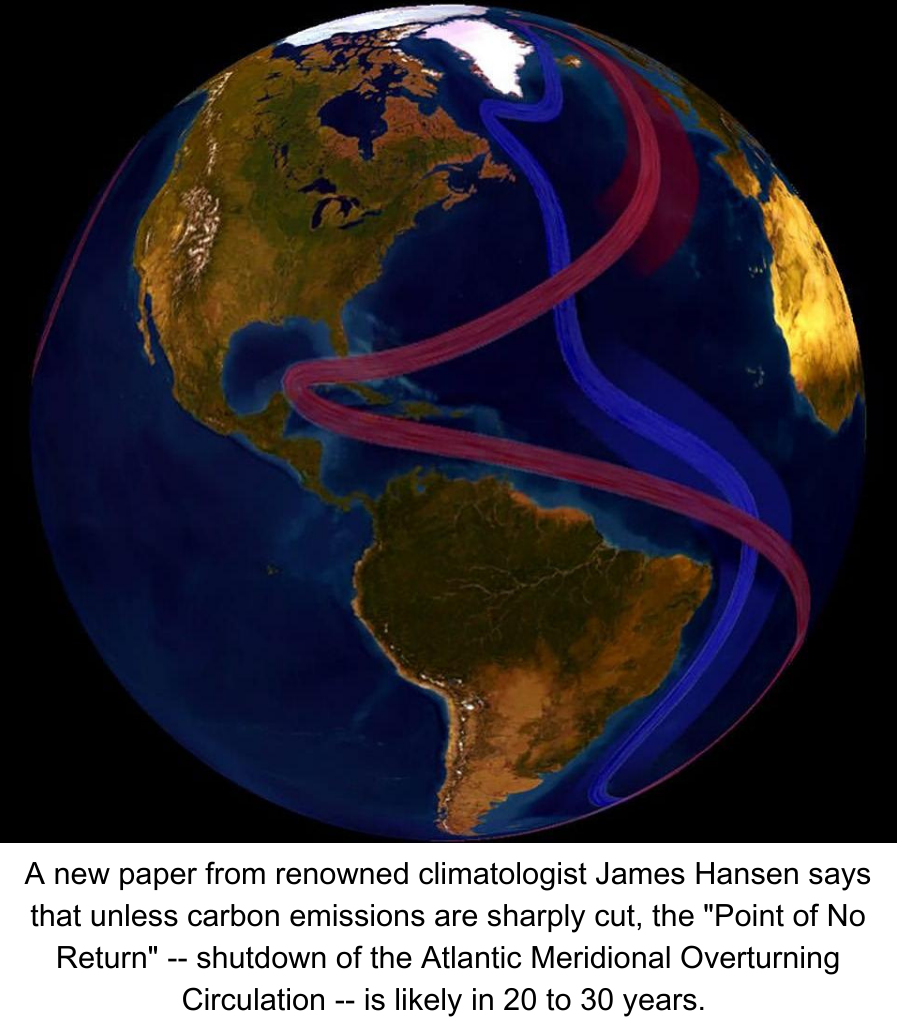by Randall Morton, founding executive director of The Progressive Forum
The following op-ed originally appeared in the Houston Chronicle on April 21, 2025.
 Pretend you’re holding a globe of the Earth in your hands. Look at the ink identifying the lands and the oceans. The thinness of that ink is equivalent to the thinness of earth’s livable atmosphere.
Pretend you’re holding a globe of the Earth in your hands. Look at the ink identifying the lands and the oceans. The thinness of that ink is equivalent to the thinness of earth’s livable atmosphere.
We’re sustained by an airy membrane. The livable atmosphere is about four miles high, above which humans require breathing assistance. This layer sits atop the earth whose diameter is about 8,000 miles. Life’s layer is a miniscule fraction of the Earth’s width. Weinhabit a slender ether of half of 1/1000 of the Earth’s width.
This should be clear: Injecting our slim naked atmosphere with gigatons of fossil fuel emissions risks existential consequences. And the risk is more urgent than we thought, according to a landmark scientific paper that the renowned climatologist James Hansen and 16 co-authors published in February.
For Houston’s fossil-fuel leaders, the new science reveals the critical moment for pivoting to true climate solutions is way overdue. And so is stopping the misinformation that pushes counterfeit solutions such as carbon capture, hydrogen, and LNG exports.
According to Hansen’s 134-page paper, “Global Warming Has Accelerated: Are the United Nations and the Public Well-Informed?”, climate sensitivity is 50% higher than previously thought. Climate sensitivity is a measure of the amount of heat-rise per doubling of CO2 in the atmosphere.
“High climate sensitivity changes everything,” says Hansen, director of Climate Science, Awareness and Solutions at Columbia University. Hansen was formerly director of the NASA Goddard Institute for Space Studies. In 1988, his Congressional testimony sparked broad awareness of the climate crisis.
In 2009, he appeared at Houston’s Progressive Forum, of which I’m founding executive director. And for the abstract of this year’s paper, I provided one of the drafts for the abstract — the part most crucial for communicating with the public.
That worrisome paper also reports that the last two years saw an unprecedented leap in global temperature. In addition, the rate of warming has accelerated by 50% per decade since 2010, over the previous rate of .18 degrees C of the last four decades.
The paper brings special focus to “the most threatening tipping point — the Point of No Return — which would be passed when it becomes impossible to avoid catastrophic loss of West Antarctic ice sheet with sea level rise of several meters.” At least half of the world’s largest cities would be substantially submerged.”
Antarctic ice loss would be triggered by a shutdown of the Atlantic Meridional Overturning Circulation (AMOC), the ocean conveyor belt that carries warm water north and cold water south in a cycle that takes a thousand years.
The circulation is driven by the sinking of heavy Arctic water, dense from cold and salt. Melting ice injects fresh water, which is lighter and warmer, into the flow which slows circulation.
Hansen and his co-authors predict that because of this, AMOC is likely to shut down “within the next 20-30 years, unless actions are taken to reduce global warming.” A shutdown means heat would stay in the southern hemisphere, where it would contribute to Antarctic ice melt.
It is the Point of No Return.
AMOC is already disrupted. Another study released in 2021 by the eminent Potsdam Institute for Climate Impact Research, said, “Never before in over 1,000 years has AMOC been as weak as in the last decades.”
Paleoclimate research supports a likely AMOC shutdown if emissions aren’t substantially cut. Hansen says that Earth is at least as warm as during the Eemian interglacial period 120,000 years ago. “Mid-Eemian sea level was about the same as today, and Antarctic and Greenland ice sheets were similar to their present sizes. Late in the Eemian period, sea level rose several meters within a century, likely from collapse of the West Antarctic ice sheet.”
The Hansen paper says that this doesn’t have to be our future. While tipping points are real, many are reversible. The climate system’s slow response allows the possibility to avoid the Point of No Return and a happy ending with restoration of a propitious climate. A downturn in emissions could alter projections within decades.
What was the new science behind the leap in climate sensitivity and the recent spike in temperatures?
In 2020, the International Maritime Organization clamped down on sulfur pollution from seagoing ships, since it hurts health and the environment. The Hansen team took the opportunity to conduct a global-scale experiment with satellites to measure effects of sulfate particles.
In general, any sort of particulates in the atmosphere — which scientists call “aerosols” — have an outsized cooling effect. Aerosols reflect incoming sunlight back into space. They’re a force-multiplier of reflection by seeding new clouds, brightening existing ones, and increasing cloud cover. With lower aerosol levels, the earth darkens and absorbs more sunlight.
What that means is this: Sulfur pollution was hiding how fast the world was warming. It masked climate sensitivity.
The Hansen team’s climate modeling shows actual climate sensitivity at about 4.5 degrees C per doubling of CO2. This is 50% higher than the index by the conservative United Nations Intergovernmental Panel on Climate Change, of only 3 degrees C. Hansen believes the IPCC should have modeled aerosols as a dynamic climate force. The threat is more imminent than the public believes.
In Houston, misinformation by civic leaders supporting Big Oil increases the risk of existential threats for the planet as well as the Houston economy. Big Oil is in decline, yet civic leaders are leaving the community vulnerable without a meaningful plan to transition to, say, the booming renewable energy industry.
Reuters just reported that “(f)ossil fuels accounted for less than 50% of the U.S. power mix for the first month on record in March, driven by a near-quarter rise in wind and solar power generation.”
Moreover, the slowing world economy is quickening Big Oil’s descent. This month, as the Houston Chronicle reported, “Crude prices shed an eye-popping $11, falling to $60 per barrel…. Chevron said in February that it would lay off as much as 20% of its global workforce by 2026.”
Yet the Greater Houston Partnership is promoting a counterfeit Energy Transition Initiative focused on carbon capture and hydrogen. These technologies sound plausible as climate solutions, but they’re merely bets on fossil fuel. For example, 95% of hydrogen in the U.S. is made from natural gas processing. Carbon capture is mainly a license to produce more oil and gas. According to the Hansen paper, “Carbon capture at the gigaton scale does not exist; the estimatedannualcost of CO2 extraction is now $2.2 to $4.5 trillion. Such hypothetical large-scale carbon capture will not happen in anything near the required timeframe.”
Similarly, many endorse the use of liquefied natural gas (LNG), promoted as a “cleaner natural gas.” According to a widely cited Cornell study led by scientist Robert Howarth, LNG leaves a greenhouse gas footprint that is 33% worse than coal when processing and shipping are taken into account.
Despite smokescreens by Big Oil, science fundamentals are well-defined. Slashing fossil fuel emissions is the only way to prevent a “likely” AMOC shutdown. Houston leaders must pivot to true climate solutions while there’s time.
Randall Morton is Founding Executive Director of the Progressive Forum. His company, Randall Morton International, was a marketing firm serving oil equipment companies in the U.S., Europe, and Japan. He’s a member of the BCarbon working group for nature-based storage of carbon at Baker Institute.On Thursday, the Progressive Forum will host a panel discussion, True Climate Solutions: Debunking the Hype Around Carbon Capture, Hydrogen, and LNG Export. Panelists will include Houston Chronicle columnist Chris Tomlinson and Cornell scientist Robert Howarth. Admission is free, but registration is recommended.